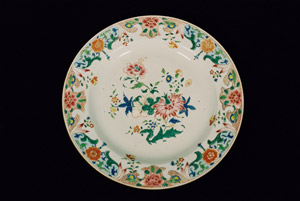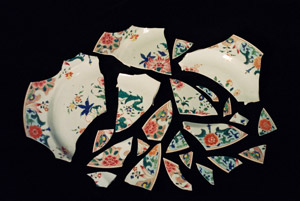 The decoration shows the object to belong to the ceramic type known in the West as ‘famille rose’, a definition invented by the French collector and author Albert Jacquemart (1808-1875) to denote the pre-eminence of pink amongst the palette colours.
The decoration shows the object to belong to the ceramic type known in the West as ‘famille rose’, a definition invented by the French collector and author Albert Jacquemart (1808-1875) to denote the pre-eminence of pink amongst the palette colours.
Production of ‘famille rose’ began in China around 1720 and was destined for the foreign market. It is characterized by the use of purple of Cassius – a colour made of gold and tin chloride from a formula brought to China by Jesuit priests from Europe, and by dilutions and nuances obtained with the opaque white that comes from arsenic.
The Chinese describe such colours as soft, dusty, opaque, in contrast with the strong, thick and translucent colours of their tradition and named them ‘Yancai’ which means ‘foreign colours’.
This plate is decorated using both opaque enamels and glossy, transparent, vitreous enamels
The floral decoration on the plate alternates on the rim with peonies and flowered shoots in the centre of the well; the palette includes iron red, pink, two shades of green, yellow, cobalt blue, turquoise and black. The over-glazed colours were probably fired at a temperature that was too low causing a very poor adhesion of the enamel to the glaze and as result the decoration fell.
 When the plate arrived in the laboratory it was in 23 pieces. Where the enamels were coming loose, there was some flaking that highlighted the glazing and, compared to the rest of the surface, was a little more opaque in those points.
When the plate arrived in the laboratory it was in 23 pieces. Where the enamels were coming loose, there was some flaking that highlighted the glazing and, compared to the rest of the surface, was a little more opaque in those points.
It was decided to limit restoration to bonding which was carried out using epoxy resin, to consolidation of the enamels which was achieved using Paraloid B72 acrylic resin, to retouching with brush and enamel colours of some extremely small missing fragments in the well.